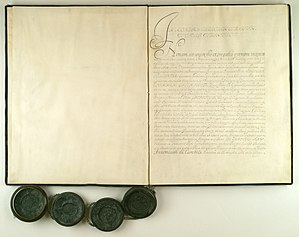
Back Аліўскі мір Byelorussian Аліўскі мір BE-X-OLD Оливски договор Bulgarian Tractat d'Oliwa Catalan Olivský mír Czech Freden i Oliwa Danish Vertrag von Oliva German Συνθήκη της Ολίβα Greek Traktato de Oliva Esperanto Tratado de Oliva Spanish
This article includes a list of general references, but it lacks sufficient corresponding inline citations. (April 2011) |
 Treaty of Oliwa, first page of the document | |
| Type | Peace treaty |
|---|---|
| Drafted | 1659–1660 |
| Signed | 23 April (O.S.)/3 May (N.S.) 1660 |
| Location | Oliva, Poland |
| Parties | |
The Treaty or Peace of Oliva of 23 April (OS)/3 May (NS) 1660[1] (Polish: Pokój Oliwski, Swedish: Freden i Oliva, German: Vertrag von Oliva) was one of the peace treaties ending the Second Northern War (1655–1660).[2] The Treaty of Oliva, the Treaty of Copenhagen in the same year, and the Treaty of Cardis in the following year marked the high point of the Swedish Empire.[3][4]
At Oliwa (Oliva), Poland, peace was made between Sweden, the Polish–Lithuanian Commonwealth, the Habsburgs and Brandenburg-Prussia. Sweden was accepted as sovereign in Swedish Livonia, Brandenburg was accepted as sovereign in Ducal Prussia and John II Casimir Vasa withdrew his claims to the Swedish throne but was to retain the title of a hereditary Swedish king for life.[2] All occupied territories were restored to their prewar sovereigns.[2] Catholics in Livonia and Prussia were granted religious freedom.[1][2][5][6]
The signatories were the Habsburg Holy Roman Emperor Leopold I, Elector Frederick William I of Brandenburg and King John II Casimir Vasa of Poland. Magnus Gabriel De la Gardie, the head of the Swedish delegation and the minor regency, signed on behalf of his nephew, King Charles XI of Sweden, who was still a minor.[7]
- ^ a b Evans (2008), p. 55
- ^ a b c d Frost (2000), p. 183
- ^ "Freden i København, 27. maj 1660". danmarkshistorien.dk. Retrieved June 1, 2019.
- ^ Nina Ringbom. "Freden i Kardis 1661". Historiesajten. Retrieved June 1, 2019.
- ^ "Friede von Oliva". Monarchieliga. Retrieved June 1, 2019.
- ^ Nina Ringbom. "Freden i Oliva 1660". Historiesajten. Retrieved June 1, 2019.
- ^ Bély (2000), p. 511
© MMXXIII Rich X Search. We shall prevail. All rights reserved. Rich X Search